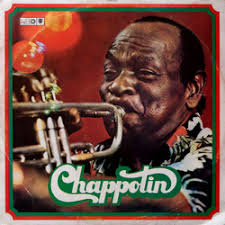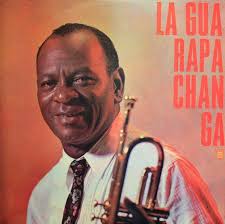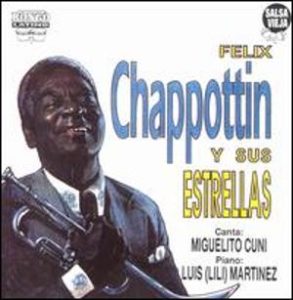
Félix Chappottín, famoso trompetista y director de orquesta cubano. Conocido popularmente como “el Louis Armstrong cubano”, formó parte de tres exitosas orquestas cubanas: el Septeto Habanero, el conjunto de Arsenio Rodríguez y el Conjunto Chappottín, del cual fue director.
CARRERA ARTÍSTICA
Félix Chappottín Lage nació el 31 de marzo de 1907 en Cayo Hueso, La Habana, hijo del músico y tabaquero Julio Chappottín y la ama de casa Natalia Lage. Su padre formó parte del grupo de son Los Apaches.
A los 8 años, Chappottín comenzó a estudiar corneta con Venancio González; posteriormente, se dedicó a la tuba, el oboe y el bombardino. A los doce años ingresó a la banda juvenil local de Guanajuay. En 1924 ingresó como trompetista a la Estudiantina Orquídea de Américo González, y en 1927 ingresó al Septeto Habanero, anteriormente Sexteto Habanero, convirtiéndose en el trompetista más famoso de Cuba.
Con El Habanero, Chappottín grabó varios sencillos de 78 rpm para Víctor entre febrero de 1928 y 1930, cuando este abandonó la banda por motivos económicos, siendo reemplazado por José Interián.[3] Luego se unió a otros septetos de son: Colín, Munamar (dirigido por Juan José Izquierdo), Agabama y Universo (dirigido por Abelardo Barroso). Tras la disolución del Sexteto Boloña en 1935, Chappottín y Jesús “Tata” Gutiérrez fundaron el Sexteto Bolero. En 1939 se incorporó al septeto Carabina de Ases.
En la década de 1940, tras la disolución de Carabina de Ases, Chappottín integró varios conjuntos: América, Gloria Cubana, Anacaona (dirigida por Concepción Castro), Azul (dirigida por Chano Pozo), Los Jóvenes del Cayo y finalmente el conjunto popular de Arsenio Rodríguez, en 1950.
En 1950, Rodríguez decidió continuar su carrera en Nueva York y los miembros de su conjunto que permanecieron en La Habana fundaron el Conjunto Chappottín, que fue dirigido por Chappottín, con arreglos de la pianista Lilí Martínez y con Miguelito Cuní como voz principal. La banda se convirtió en uno de los conjuntos más populares de la década de 1950 con éxitos como “Alto Songo”.
Chappottín siguió siendo el líder de su conjunto hasta su muerte, ocurrida el 21 de diciembre de 1983, en La Habana.
LEGADO
Chappottín es ampliamente reconocido como el fundador del estilo moderno de trompeta cubana debido a su enfoque innovador en el desarrollo del son cubano entre las décadas de 1920 y 1950.
Según Craig Harris, escritor de AllMusic, Chappottín “continuó inspirando la música afrocubana con su dulce interpretación de trompeta durante más de seis décadas”. Se le compara con el famoso trompetista estadounidense Louis Armstrong. En 2002, Chappottín fue incluido póstumamente en el Salón de la Fama Internacional de la Música Latina.
Tras su fallecimiento, su hijo y posteriormente su nieto dirigieron el Conjunto Chappottín.
CHAPPOTIN Y SUS ESTRELLAS. SU LEGADO
El Conjunto Chappottín es uno de los grupos de son más importantes de Cuba. Su fundación se remonta a la década de 1940, bajo la dirección de su fundador, Arsenio Rodríguez, uno de los líderes de orquesta más reconocidos del país, con una gran influencia en el jazz latino y la salsa de las décadas posteriores. Con su Conjunto, fue el primero en incorporar instrumentos de lengüeta y metal a una banda latina de la época.
Cuando Arsenio salió de Cuba en 1950 para someterse a un tratamiento oftalmológico en Nueva York, cedió la dirección musical a su primer trompetista, Félix Chappottín. La banda pasó a llamarse Félix Chappottín y su Conjunto Todas Estrellas. Félix Chappottín dirigió la banda con éxito hasta su fallecimiento en 1983.
Desde 1983 hasta la década de 1990, su hijo Ángel Chappottín Valdés fue el director musical y, desde entonces, su nieto, Jesús Ángel Chappottín Coto, ha dirigido el Conjunto Chappottín junto con Miguelito Cuni Jr., cantante y percusionista. Miguelito Cuni es hijo del exvocalista Miguel Cuni.
Desde 1983, la banda se conoce como Conjunto Chappottín y Sus Estrellas. El Conjunto Chappottín y Sus Estrellas es una de las agrupaciones de son más reconocidas de Cuba y, desde entonces, se ha presentado en las principales salas de conciertos cubanas y en numerosos países de Latinoamérica, Europa y África.
La banda se dedica al son tradicional con una variedad de elementos estilísticos como el son-montuno, la guajira, la guaracha, el mambo, el danzón, la danzonette, la charanga, el afro-son, el b be, la rumba (compuesta por yambú, columbia guaguancó) y el cha cha chá. Con la incorporación del grupo de instrumentos de viento Arsenio Rodríguez, la banda cambió el enfoque tradicional de las agrupaciones de son y, bajo la dirección de su sucesor, Félix Chappottín, a menudo comparado con Louis Armstrong, la banda alcanzó reconocimiento internacional.

FELIX CHAPOTTIN “THE CUBAN LOUIS AMSTRONG”, TRUMPETER AND BANDLEADER. DIRECTER OF CHAPPOTTI AND HIS STARS. PHOTOS.
Félix Chappottín, a famous Cuban trumpeter and bandleader. Populary known as “the Cuban Louis Armstrong” was a member of three highly successful Cuban bands: Septeto Habanero, Arsenio Rodríguez’s conjunto and Conjunto Chappottín, which he directed.
ARTISTIC CAREER
Félix Chappottín Lage was born on March 31, 1907, in Cayo Hueso, Havana, to tobacconist/musician Julio Chappottín and housewife Natalia Lage. His father was a member of the son group Los Apaches.
At 8 years of age, Chappottín began to study cornet under Venancio González; he later took up the tuba, the oboe and the euphonium. At age twelve he joined the local youth band of Guanajuay. In 1924 he joined the Estudiantina Orquídea de Américo González as trumpeter, and in 1927, he joined the Septeto Habanero, previously the Sexteto Habanero, becoming the most famous trumpeter in Cuba.
With the Habanero, Chappottín recorded several 78 rpm singles for Victor between February 1928 and 1930, when he left the band for economic reasons, being replaced by José Interián.[3] He then joined other son septetos: Colín, Munamar (directed by Juan José Izquierdo), Agabama, and Universo (directed by Abelardo Barroso). After the disbandment of Sexteto Boloña in 1935, Chappottín and Jesús “Tata” Gutiérrez founded the Sexteto Bolero. In 1939 he joined the septeto Carabina de Ases.
CONJUNTO ERA
In the 1940s, after the disbandment of Carabina de Ases, Chappottín joined several conjuntos: América, Gloria Cubana, Anacaona (directed by Concepción Castro), Azul (directed by Chano Pozo), Los Jóvenes del Cayo and finally Arsenio Rodríguez’s popular conjunto, in 1950.
In 1950, Rodríguez decided to continue his career in New York and the members of his conjunto that remained in Havana founded Conjunto Chappottín, which was directed by Chappottín, with the arrangements of pianist Lilí Martínez and featuring Miguelito Cuní on lead vocals. The band became one of the most popular conjuntos of the 1950s with hits such as “Alto Songo”.
Chappottín remained the leader of his conjunto until his death, which took place on December 21, 1983, in Havana.
Chappottín is widely regarded as the founder of the modern Cuban trumpet style due to his innovative approach in the development of son cubano between the 1920s and 1950s.
According to Craig Harris, writer for AllMusic, Chappottín “continued to inspire Afro-Cuban music with his sweet-toned trumpet playing for more than six decades”. He was compare with American famous trumpeter Louis Armstrong. In 2002, Chappottín was posthumously inducted into the International Latin Music Hall of Fame.
After his death, his son and later his grandson have directed Conjunto Chappottín.
CHAPPOTTIN AND HIS STARS. LEGACY
Conjunto Chappottín is one of Cuba’s top son groups. The founding of the band dates back to the 1940s to its founder Arsenio Rodriguez, one the country’s most renowned band leaders with major influences on the Latin jazz and Salsa music of the next decades. With his Conjunto he was the first to add reed and brass instruments to a Latin band at that time.
When Arsenio left Cuba in 1950 to undergo an ophthalmological treatment in New York, he handed the musical direction over to his first trumpet player, Felix Chappottín. The band was renamed Felix Chappottín y su Conjunto Todos Estrellas. Felix Chappottín directed the band successfully until the year of his death in 1983.
From 1983 until the 1990s his son Angel Chappottín Valdes was musical director and since then the grandson of Felix Chappottín, Jesus Angel Chappottín Coto has directed the Conjunto Chappottín together Miguelito Cuni Jr., singer/percussionist. Miguelito Cuni is the son of the former lead singer, Miguel Cuni.
Since 1983 the band has been known as Conjunto Chappottín y Sus Estrellas. Conjunto Chappottín y Sus Estrellas is one of the most renowned son bands in Cuba and has since performed in the major Cuban music halls and in many Latin American, European, and African countries.
The band is dedicated to the traditional son with a variety of different stylistic elements such as son-montuno, guajira, guaracha, mambo, danzon, danzonette, charanga, afro-son, b be, rumba (made up of yambu, columbia guaguanco), and cha cha cha. With the additional horn group Arsenio Rodriguez changed the traditional setting of a son band and under the direction of his successor, Felix Chappottín, who was often compared with Louis Armstrong, the band gained international reputation.

Agencies/ Wiki/ Felix ChappottinBio./ Internet Photos/ Arnoldo Varona.
www.TheCubanHistory.com
THE CUBAN HISTORY, HOLLYWOOD.




